March 2022
March 21, 2022
A New Method for getting Gold from Wheat
In 1884, Harry Fell of South Norwood Park was granted Patent No. 14,204 by the British Patent Office for a "New Method for getting Gold from Wheat". This begs the question, what was the old method of getting gold from wheat?I haven't been able to find a copy of the patent, since 19th-century British patents (unlike American ones) aren't readily available online. However, the March 5, 1997 issue of Science offered a full transcript of Fell's patent, "including the peculiar use of punctuation marks".
The April 24, 1885 issue of The Photographic News offered an easier-to-understand summary of Fell's method:
Of course, what Fell had failed to mention was that the wheat would first have to be grown in soil containing a lot of gold. Then, yes, I think it would be possible to get gold from wheat using his method. Though it would probably be easier to get it by directly filtering the gold out of the dirt.
Posted By: Alex - Mon Mar 21, 2022 -
Comments (1)
Category: Patents, Nineteenth Century
The IEV X
Driver's butt is in passenger's crotch. Got it.
Posted By: Paul - Mon Mar 21, 2022 -
Comments (3)
Category: Inventions, Chindogu, Unwanted Intimacy, Close Quarters and Tight Squeeze, Cars
March 20, 2022
Spoon bracelet fad alarms cafeterias
Spoon bending, pre-Uri Geller.
Des Moines Register - Oct 15, 1939

Hastings Morning Spotlight - Dec 27, 1938
Posted By: Alex - Sun Mar 20, 2022 -
Comments (2)
Category: Fads, Fashion, 1930s
Dr. Seuss House, Alaska
Video should start at the proper segment. Otherwise, minute 41.
Posted By: Paul - Sun Mar 20, 2022 -
Comments (0)
Category: Architecture, Eccentrics
March 19, 2022
The Ice Cream Virgin
January 2000: a melted ice cream stain in front of a soda machine in Houston attracted pilgrims when people noticed that the stain kinda/sorta looked like the Virgin of Guadalupe.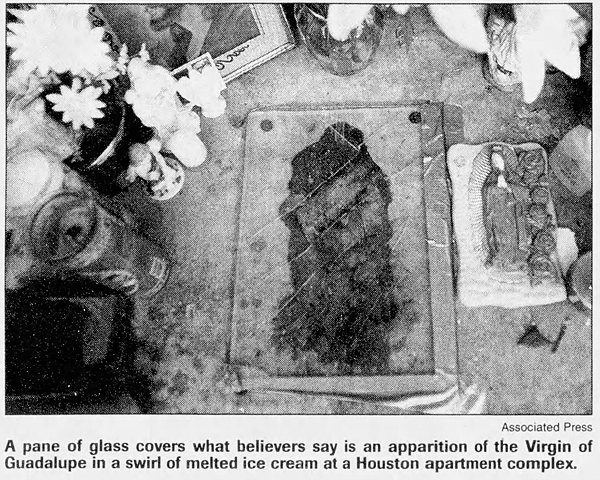
Corpus Christi Caller-Times - Jan 14, 2000
Some analysis from an article by J. Rhett Rushing ("Homemade Religion: Miraculous Images of Jesus and the Virgin Mary in South Texas") that appeared in 2001: A Texas Folklore Odyssey.
Unsettling to the Catholic clergy and other, more formal religious folks, these widespread images of religious figures are not only immediately accepted by some of the local believers, but in fact, are quite expected.. . .
At a southside Houston apartment complex in February of 2000, I witnessed a "folk mass" of nine women praying, taking a version of communion, and supplicating themselves to an image of the Virgin that miraculously appeared in a melting ice cream spill next to the laundry room's Coke machine. Later interviews confirmed that the group had no leader and certainly no church sanction for their activities, but as Maria B. explained, "When the Virgin comes to see you, you don't wait for the priest."
Maria's remark seems to be the mantra for South Texas Hispanic Catholics. Historically underserved by the Catholic Church, religion for many was learned and practice at the altarcitas and grutas of the family.
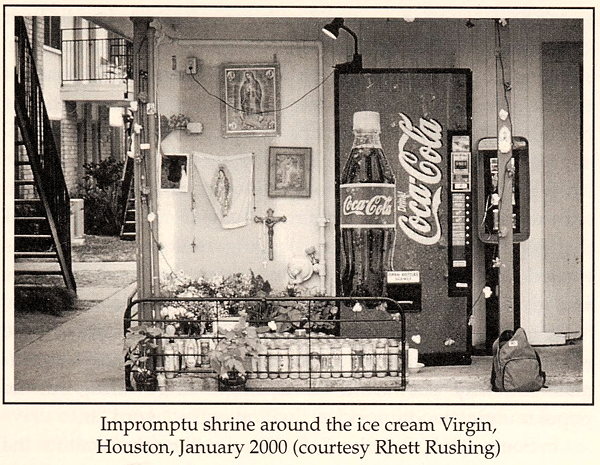
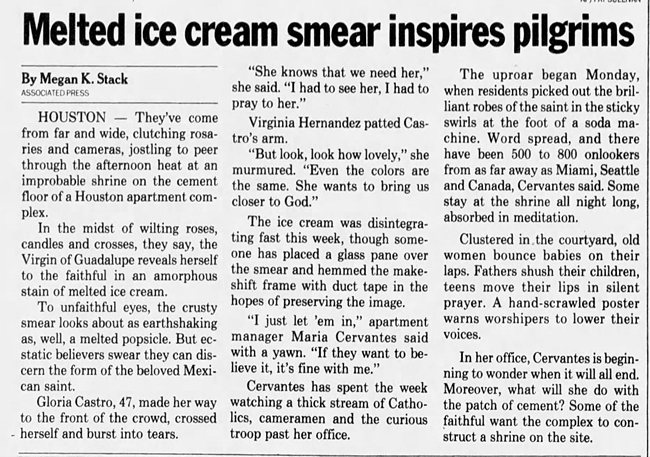
San Francisco Examiner - Jan 14, 2000
Posted By: Alex - Sat Mar 19, 2022 -
Comments (1)
Category: Religion, 2000s, Pareidolia
America’s Fattest Presidents
A 2013 article at this link ranks the weightiest of our leaders. Of course, former-President Trump is not included. This official 2020 health report puts him at 244 pounds, making him, by my calculations, Number Three.Number Two, Grover Cleveland, tried many times to lose. His personal physician, Dr. John Gibbs, was fond of a new German treatment.

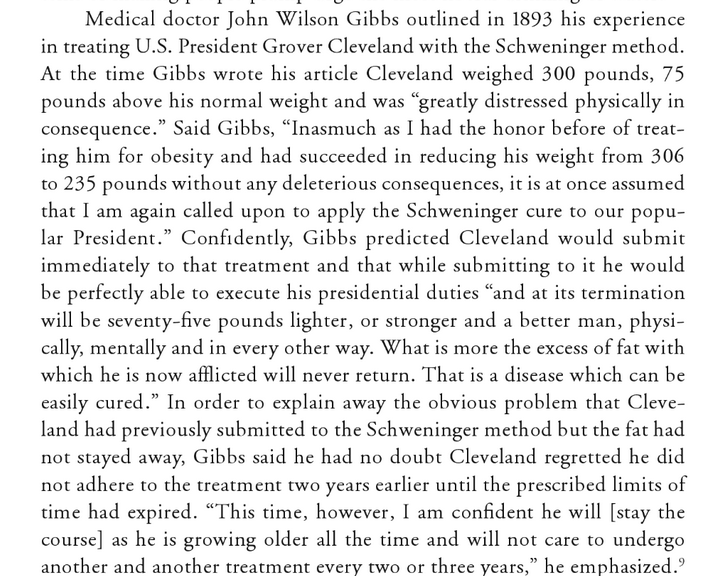
Read more in this book, which is partially available via Google Books.

Posted By: Paul - Sat Mar 19, 2022 -
Comments (2)
Category: Government, Patent Medicines, Nostrums and Snake Oil, Nineteenth Century, Twenty-first Century, Obesity
March 18, 2022
Death by Drama
Paul posted last week about a real-life murder that occurred onstage during a play. This reminded me of another onstage death I once read about in Jody Enders' book Death By Drama and Other Medieval Urban Legends.The death is said to have occurred in 1549, during a performance of the play Judith and Holofernes, which tells the Biblical (or Biblical apocrypha) story of Judith who cuts off the head of an Assyrian general, Holofernes. The producers of the play supposedly decided it would add a touch of realism if the actor playing Holofernes really was decapitated.
The details from Enders' book:
Jean de Bury and Jean de Crehan, duly charged with decorating the streets, had imagined rendering in its purest form the biblical exploit of Judith. Consequently, for filling the role of Holofernes, a criminal had been chosen who had been condemned to have his flesh torn with red-hot pincers. This poor fellow, guilty of several murders and ensconced in heresy, had preferred decapitation to the horrible torture to which he had been condemned, hoping, perhaps, that a young girl would have neither the force nor the courage to cut off his head. But the organizers, having had the same concern, had substituted for the real Judith a young man who had been condemned to banishment and to whom a pardon was promised if he played his role well.
The story goes that the two substitutions were accepted by the two unnamed men. Being an actor / executioner was apparently preferable to being banished, and death by decapitation during drama was preferable to being skinned alive (something that the Eel of Melun might himself have understood).
"Judith" had only one condition to meet: to provide acting so good that it wasn't acting at all. . .
The fantastic narrative next shows Philip arriving just as the axe is falling. As real blood supposedly begins to flow, it prompts applause in some, indignation in others, and curiosity in the prince, who remains implacable as the body of "Holofernes" goes through its last spasms:
In fact, as Philip approached the theater where the mystery play was being represented, the so-called Judith unsheathed a well-sharpened scimitar and, seizing the hair of Holofernes, who was pretending to be asleep, dealt him a single blow with so much skill and vigor that his head was separated from his body. At the [sight of] the streams of blood that spurted out from the neck of the victim, frenetic applause and cries of indignation rose up from amid the spectators. Only the young prince remained impassive, observing the convulsions of the decapitated man with curiosity and saying to his noble entourage: "nice blow".

Enders has doubts this onstage execution ever really took place, but can't rule out the possibility altogether.
In the story's favor: Philip II really did go to Tournai in 1549; Jehan de Crehan was a real person; there really were plays performed in Philip's honor; and Tournai had a history of executing heretics, and of offering decapitation as a "kinder" alternative to more gruesome forms of execution.
The points against the story's veracity: not a single, extant contemporaneous source mentions this onstage decapitation. The first references to it only appear several hundred years later. And it stretches credulity to imagine that a condemned prisoner would obligingly play his part in the performance, even to the extent of pretending to be asleep before he was decapitated.

Posted By: Alex - Fri Mar 18, 2022 -
Comments (4)
Category: Death, Theater and Stage, Fables, Myths, Urban Legends, Rumors, Water-Cooler Lore, Sixteenth Century
Vasilisa & The Hungry Doll
Posted By: Paul - Fri Mar 18, 2022 -
Comments (0)
Category: Family, Hobbies and DIY, Movies, Rituals and Superstitions, Supernatural, Occult, Paranormal, Myths and Fairytales, Dolls and Stuffed Animals
March 17, 2022
Happy Evacuation Day
On March 17, 1776, British troops evacuated from Boston.To commemmorate this event, in 1901 the city of Boston declared March 17 to be a holiday called "Evacuation Day".
By happy coincidence, March 17 was also, of course, St. Patrick's Day.
More info: wikipedia

Source: NY Public Library
Posted By: Alex - Thu Mar 17, 2022 -
Comments (1)
Category: Holidays
Rocket-Powered Iceboat
Before we leave winter behind entirely, let us ponder this refinement of a cold-weather recreation.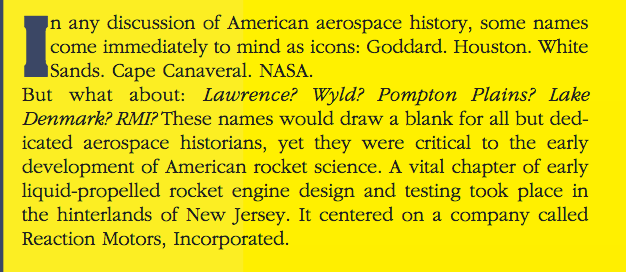
This company had a rich and fascinating aeronautical history which you can read at the link. But surely we afficionados of the weird will want to honor them for creating a rocket-propelled iceboat.

Rocket iceboat can do 250 miles per hour A rocket-propelled iceboat capable of a speed of 250 miles an hour on smooth ice has been designed by Reaction Motors , Inc of America , and tested on frozen Lake Hopatcong New Jersey . The boat weighs 1,648 pounds. Photo shows: The iceboat streaking over Lake Hopatcong piloted by Puck Wellington. It was travelling at 95 miles an hour , rough ice and snow patches made higher speeds dangerous . 7 March 1947
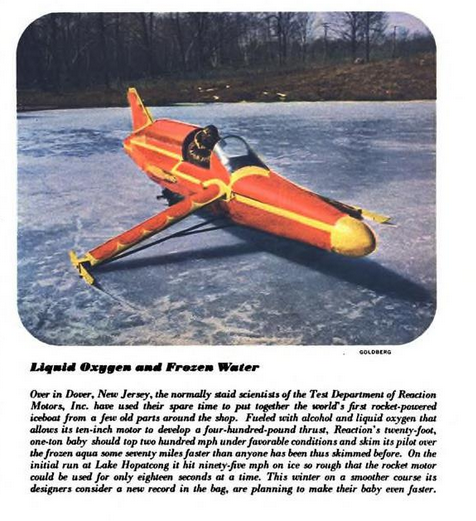
Posted By: Paul - Thu Mar 17, 2022 -
Comments (1)
Category: Death, Oceans and Maritime Pursuits, Technology, 1940s, Outrageous Excess
| Get WU Posts by Email | |
|---|---|

| Who We Are |
|---|
| Alex Boese Alex is the creator and curator of the Museum of Hoaxes. He's also the author of various weird, non-fiction books such as Elephants on Acid. Paul Di Filippo Paul has been paid to put weird ideas into fictional form for over thirty years, in his career as a noted science fiction writer. He has recently begun blogging on many curious topics with three fellow writers at The Inferior 4+1. Chuck Shepherd Chuck is the purveyor of News of the Weird, the syndicated column which for decades has set the gold-standard for reporting on oddities and the bizarre. Our banner was drawn by the legendary underground cartoonist Rick Altergott. Contact Us |

